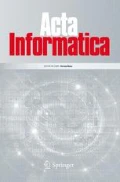Abstract
The P systems (or membrane systems) are a class of distributed parallel computing devices of a biochemical type, where membrane division is the frequently investigated way for obtaining an exponential working space in a linear time, and on this basis solving hard problems, typically NP-complete problems, in polynomial (often, linear) time. In this paper, using another way to obtain exponential working space – membrane separation, it was shown that Satisfiability Problem and Hamiltonian Path Problem can be deterministically solved in linear or polynomial time by a uniform family of P systems with separation rules, where separation rules are not changing labels, but polarizations are used. Some related open problems are mentioned.
Similar content being viewed by others
References
Alhazov A., Martí n-Vide C., Pan L. (2003). Solving a PSPACE-complete problem by P systems with restricted active membranes. Fundam. Inf. 58(2):66–77
Alhazov A., Pan L. (2004). Polarizationless P systems with active membranes. Grammars 7(1):141–159
Alhazov A., Pan L., Păun Gh. (2004). Trading polarizations for labels in P systems with active membranes. Acta Inf. 41:111–144
Alhazov, A., Ishdorj, T.-O.: Membrane Operations in P Systems with Active Membranes. In: Păun, Gh., Riscos-Núñez, A., Romero-Jiménez, A., Sancho-Capparini, F. (eds.) Second Brainstorming Week on Membrane Computing, Sevilla, 2–7 February. Research Group in Natural Computing TR 01/2004, University of Sevilla, 37–44 (2004)
Burger K.N.J. (2000). Greasing membrane fusion and fission machineries. Traffic 1:605–613
Garey, M.R., Johnson, D.J.: Computers and Intractability. A Guide to the Theory of NP-Completeness. W. H. Freeman, San Francisco (1979).
Pan, L., Alhazov, A., Ishdorj, T.-O.: Further Remarks on P Systems with Active Membranes, Separation, Merging and Release Rules. In: Păun, Gh., Riscos-Núñez, A., Romero-Jiménez, A., Sancho-Capparini, F. (eds.) Second Brainstorming Week on Membrane Computing, Sevilla, 2–7 February. Research Group in Natural Computing TR 01/2004, University of Sevilla, pp. 316–324. Also in Soft Comput. 8, 1–5 (2004)
Papadimitriou Ch.P. (1994). Computational Complexity, Addison-Wesley, Reading
Păun A. (2000). On P Systems with Membrane Division. In: Antoniou I., Calude C.S., Dinneen M.J. (eds) Unconventional Models of Computation. Springer, London, pp. 187–201
Păun Gh. (2000). Computing with membranes. J. Comput. Syst. Sci. 61(1):108–143
Păun Gh. (2001). P systems with active membranes: attacking NP-complete problems. J. Automata Lang. Combinatorics 6(1):75–90
Păun Gh. (2002). Computing with Membranes: an introduction. Springer, Berlin Heidelberg New York
Pérez-Jiménez M.J., Romero-Jiménez A., Sancho-Caparrini F. (2003). Complexity classes in models of cellular computation with membranes. Nat. Comput. 2(3):265–285
Pérez-Jiménez, M.J., Romero-Jiménez, A., Sancho-Caparrini, F.: Teoría de la Complejidad en Modelos de Computatión Celular con Membranas, Editorial Kronos, Sevilla, (2002)
Rozenberg G., Salomaa A. (eds) (1997). Handbook of Formal Languages (3 volumes). Springer, Berlin Heidelberg New York
Salomaa A. (1973). Formal Languages. Academic, New York
Sosí k, P.: Solving a PSPACE-Complete Problem by P Systems with Active Membranes. In: Proceedings of the Brainstorming Week on Membrane Computing (Cavaliere, M., Martín-Vide, C., Păun, Gh. (eds.) Report GRLMC 26/03, pp 305–312 (2003)
Author information
Authors and Affiliations
Corresponding author
Rights and permissions
About this article
Cite this article
Pan, L., Alhazov, A. Solving HPP and SAT by P Systems with Active Membranes and Separation Rules. Acta Informatica 43, 131–145 (2006). https://doi.org/10.1007/s00236-006-0018-8
Received:
Revised:
Published:
Issue Date:
DOI: https://doi.org/10.1007/s00236-006-0018-8



